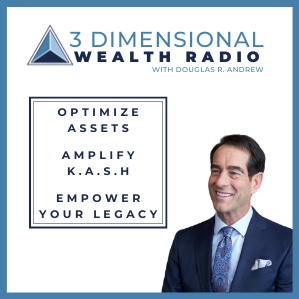Want to avoid accessing your money the dumb way (and put off the sad way as long as possible)? Here’s how …
Let’s say you have a properly structured, maximum-funded Indexed Universal Life policy, what I call a LASER Fund. And now let’s assume you’d like to access money in your policy for tax-free retirement income. Or a business venture. Or maybe your granddaughter is headed to med school and you want to help with the hundreds of thousands owed in tuition.
Whatever you do, don’t do it the dumb way, by withdrawing your money. (For more on why withdrawing money can be disadvantageous, check out this blog article.)
And since the sad way to access your money is by passing away (and transferring the money inside your policy to your heirs income-tax-free), let’s put that off as long as possible (rest well, eat healthily, exercise, manage stress, stay connected to loved ones, and take care of yourself!).
Instead, do what other savvy millionaires and billionaires do. Access it the smart way, by borrowing it.
People who assume LASER Funds are like other traditional retirement accounts often ask: Why borrow my own money when I could just withdraw it? That way I’ll save, because when you borrow your money, they have to charge you interest or something, right?
Well, yes, you’ll be charged nominal interest on your policy loan, but that interest isn’t a negative, and in fact it can be very positive. Here’s how it works…
To use a simple example, let’s say you have $1 million dollars in your insurance policy, and it’s been earning an average of 10% over the last 25 years, thanks to your indexing strategies. (Historically, our clients have earned 5% to 10%.) In this example, you could access $100,000 dollars of annual interest without depleting your $1 million dollar principal.
Well, if you withdraw it, after you’ve recovered whatever you invested into that, you’re going to have to pay taxes on that $100,000 every year.
Instead, if you borrow it with a loan, that annual $100,000 will be income-tax-free. How? Loans are not not deemed earned, passive, or portfolio income, and ever since the 1986 tax reform, those are the only three types of income people in America pay income tax on.
Now about that interest thing. To have it qualify as a true loan, the insurance company has to charge a nominal interest rate, so you can borrow it with a Zero Wash Loan or an Alternate Loan.
A Zero Wash Loan (also known as a Standard Loan or a Declared Rate Loan) allows you to borrow money out of your policy at a fixed rate set by the insurance companies, typically 2% to 4%. (Remember every insurance company is slightly different with the rates charged and the features of each policy.)
Let’s look at an example of a Zero Wash Loan. Let’s say you have $1 million in cash value inside your policy. You would like to borrow $100,000.
Since you don’t want to do it the Dumb Way (by taking out withdrawals), you do it the Smart Way to keep it tax-free—you borrow the $100,000, in this case as a Zero Wash Loan. Your loan is being charged a fixed interest rate of, let’s say 3% in this example.
Since it’s a loan and not a withdrawal, you still have $1 million in cash value inside your policy. But keep in mind, $100,000 of that $1 million is not earning indexed returns any longer. It is now working as the collateral for the loan, so it earns a different rate, and in this example, it is earning a fixed rate of 3%.
In summary, in this example, you have $1 million in cash value in your policy; $900,000 of that $1 million is earning the indexed returns (which average 5% to 10%); and the $100,000 that is acting as collateral is earning a fixed return of 3%. So the 3% charged in interest and the 3% earned in interest essentially becomes a zero wash, thus the name: Zero Wash Loan.
While you still have $1 million in cash value in your policy, you have a $100,000 debt as well, leaving you a net cash value of $900,000. As we’ve mentioned, this loan is not due until you die, at which point it would be paid off by your policy’s cash value and death benefit before the remaining death benefit transfers income-tax-free to your heirs. (Of course, you may also choose to repay the loan at any time, thus adding money back into your policy that can go to work earning indexed returns, tax-free.)
But here is an even smarter way to do it. This is what millionaires and billionaires do; they understand how money works, and they do what banks and credit unions do. They use OPM (Other People’s Money) to get ahead.
Instead of a Zero Wash Loan, if you think the economy is going to be growing at a rate greater than the General Account Portfolio rate, you can opt, in any given year, to do what is called an Alternate Loan (also called an Index Loan, Participating Loan, Variable Loan, or a Spread Loan). Let me share with you how that works.
With Alternate Loans, you borrow at a rate set by the insurance companies. This rate is often variable—for reference, it’s currently around 4.4% to 5%. This rate also often has a cap of around 7.5% to 8%, which is the highest rate the insurance company would charge. Keep in mind, this rate would likely only go this high if the economy were experiencing a general environment of sky high interest rates—and on the reverse side, this would likely mean your indexed returns are earning much higher rates as well, helping offset the impact of your loan’s interest rate.
Unlike Zero Wash Loans, with Alternate Loans, the cash value acting as collateral for the loan will continue to earn the indexed returns. This is a significant benefit, as it allows the full $1 million in cash value to continue to grow at your indexed return rate (rates that historically average around 5% to 10% tax-free).
As an example, let’s say you have $1 million in cash value in your policy. You want to borrow $100,000 (which again, is the Smart Way, as it allows you to access your money tax-free).
Let’s say the borrowing rate on your Alternate Loan is 5%. While $100,000 of your $1 million cash value is acting as collateral for the loan, the entire $1 million in cash value continues to earn the indexed returns (in this example, we’ll say that’s an average of 7%). This yields you an average positive spread of 2%.
This might not seem like much at first glance, but that 2% spread is on money you’ve borrowed. Over time, that spread can generate a lot more income than the Zero Wash Loan.
Can I tell you something? In the year 2017, we had many clients who borrowed money for their business. As an example, let’s say one of our clients borrowed $1 million dollars, and they were charged 5% on their IUL policy ($50,000 on that million-dollar loan that year).
But guess what they earned. Many earned 16%. So they made $160,000 on the money they didn’t withdraw. Doing the math, $160,000 minus $50,000 netted them $110,000 tax-free on their money, even though they were using it for something else.
This is how millionaires and billionaires manage their money. It’s called arbitrage. It’s creating the spread. This is how money really works. And this is why you want to borrow your own money in your IUL rather than withdraw it.
WANT TO LEARN MORE?
Watch the Video – Watch the related YouTube video to see me explain “Why Borrow My Own Money in an IUL Instead of Withdrawing It?” (and while you’re there, be sure to subscribe to my YouTube channel so you don’t miss a thing!).
Elevate Your Financial Dimension – Find out how you can improve your Financial Dimension journey and seize the liquidity, safety, predictable rates of return, and tax advantages of a LASER Fund. Explore the in-depth financial strategies and learn from real-life client experiences by claiming your free copy of “The LASER Fund” book at LASERFund.com. Just pay for shipping and handling, and we will send it to you, absolutely free.
Join a Webinar – Want to find out if a LASER Fund (a maximum-funded, properly structured indexed universal life insurance policy) is right for you? Join us for an upcoming webinar where you can explore these strategies.


